Looking back: Australians on Crete - The legacy
Ironically, with its conquest, Crete lost its strategic importance to both sides. The German soldiers and airmen who had fought the battle soon departed to join in Hitler’s next aggression, the invasion of the Soviet Union. For the British, the real threat to Egypt was Rommel’s Afrika Korps in North Africa. Instead of a springboard to further conquest, the island became a backwater garrison post, of little future importance.
For the people of Crete the war against the Germans did not end with the British evacuation. A proud race, the Cretans refused to accept conquest, and a fierce resistance movement arose in the mountains and isolated villages. The Germans responded savagely, with mass executions and burning of entire villages, but were unable to quell the uprising. At one point there were 75,000 Germans on Crete, but still the people resisted.
Time has covered over the scars of battle that swept over Crete in 1941, but, like the ruins of the ancient Minoans, their memory remains. A Commonwealth cemetery with 1,509 graves overlooks Suda Bay, and at Retimo stands a monument to the Australians. At Maleme there is a German cemetery containing 4,465 dead. Dotted around the island are plaques and memorials to the fallen of the many small, but vicious, actions the two sides fought.
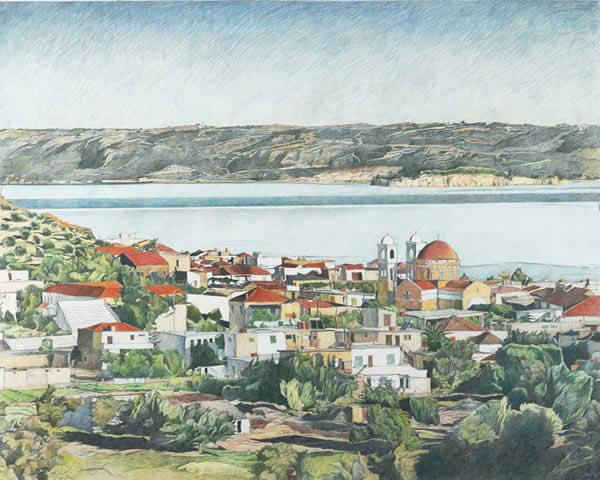
Michael Winters
Crete, morning light, Suda Bay
pencil, coloured pencil on card
drawn in Crete in 1991
81 x 101 cm
OL00475.060
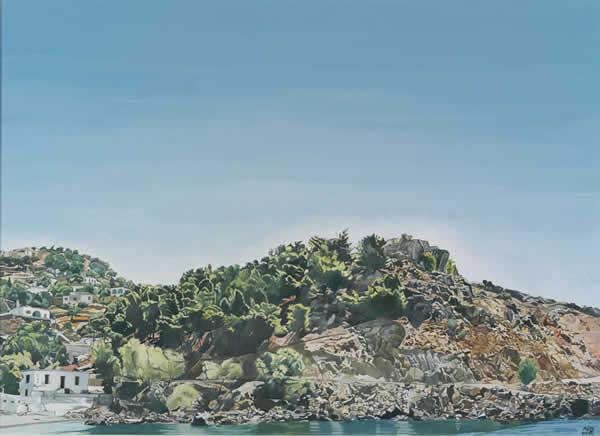
Michael Winters
Pines, Hora Sfakia
coloured gouache on card
painted in Crete in 1990
33 x 45.5 cm
OL00475.059
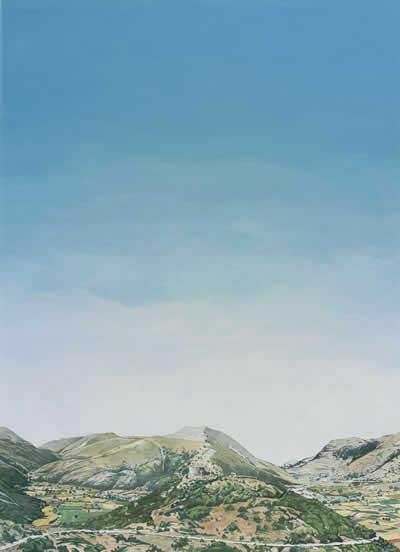
Michael Winters
A sign of old conflict in the landscape (on the road to Hora Sfakia)
coloured gouache on card
painted in Crete in 1991
45.5 x 33 cm
OL00475.058
Hora Sfakia a small village situated on the bony south coast of Crete, was the point where Allied ships evacuated what troops they could. On the rocky hillside is a small fort, Arkadi, which was strategically important in the struggle against the Turks during the Cretan War of Independence in the 1800’s.
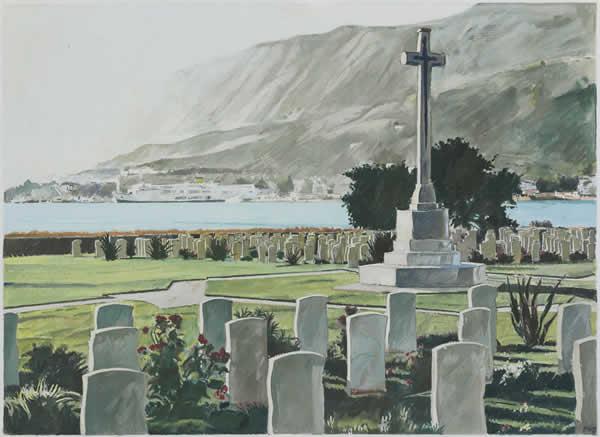
Michael Winters
The Commonwealth cemetery, Suda Bay
coloured gouache on card
drawn in Crete in 2004
33 x 45.5 cm
OL00475.061
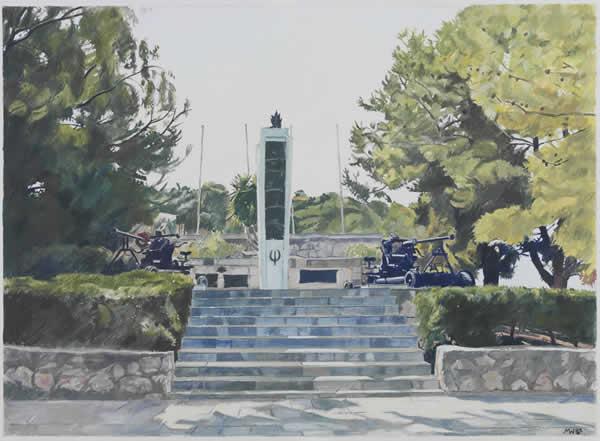
Michael Winters
The Australian Memorial, Stavromenos
coloured gouache on card
painted in Crete in 2004
33 x 45.5 cm
OL00475.062
The Australian Memorial in Stavromenos was built to honour the Australians who served in the Crete Campaign and to recognise the Greek soldiers and Cretan people who fought alongside them.
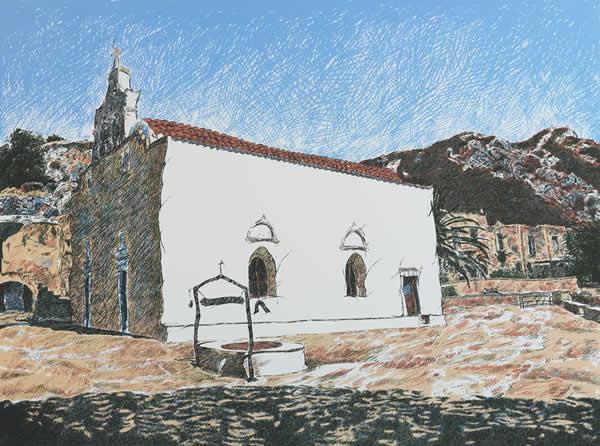
Michael Winters
Moni Prevali, Crete
coloured silk screen print on paper
printed in Canberra in 2004
56 x 76 cm
OL00475.064
Moni Prevali is an ancient monastery located on the harsh south coast of the island of Crete. The south coast of the island was the escape route used by Allied troops evading capture after the battle was lost. Moni Prevali acted as a safe haven for a number of Allied soldiers as they waited to be escape from the island. In Western Australia where the Margaret River meets the Indian Ocean there is an area named Prevelly Park. The park was named by a veteran, Geoff Edwards, after the Greek Monastery Moni Prevali as he was one of the soldiers who sheltered there during the evacuation. Edwards also built a chapel on the hill overlooking the sea in the memory of the civilians that helped him.
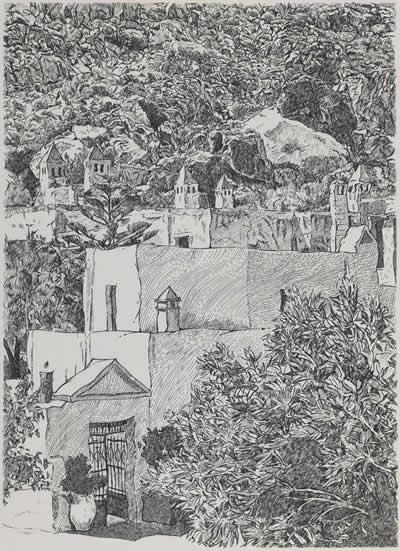
Michael Winters
Monks’ cells Moni Prevali
pen and ink on card
painted in Crete in 2004
45.5 x 33 cm
OL00475.063
![From within the Fortezza-Rethymnon [Retimo]](/sites/default/files/styles/main_content/public/97351/image/ol004750651.jpg?itok=-pgORX6N)
Michael Winters
From within the Fortezza-Rethymnon [Retimo]
coloured silk screen print on paper
printed in Canberra in 2004
56 x 76 cm
OL00475.065
The Fortezza which dominates Rethymnon is thought to be the largest Venetian castle ever built. It was built from 1573 to 1580 and was originally designed to shelter the entire population during the threat of an invasion from the Turkish. During the Second World War the German soldiers used a room of the Fortezza as a holding place for Cretan resistance fighters before they were all executed.

Michael Winters
The light of the moon, a woman and children, amid the graves of Suda
pen and ink on card
drawn in Canberra in 2004
45.5 x 33 cm
OL00475.057
A woman and children wander in the evening through the Commonwealth Cemetery overlooking Suda Bay which holds over 1500 graves.
OL00475.057

Michael Winters
The poet, his poems and his dark memories told at Easter
pen and ink on card
drawn in Crete in 1990
52.5 x 37.5 cm
OL00475.016
This was the first work Michael Winters did in the series about the Crete Campaign. Winters was a guest of Bishop Irinaos, at the Orthodox Academy of Crete on Easter Sunday in 1990. During lunch one of the other guests told Winters that he wrote poems and would like to share them with him. He read passionate accounts of the battle and loss as was experienced by the people of Crete. ‘As he read I saw in my imagination the villages in flames, a destructive bird like figure descend from the sky and all around me was the present, my son turning a goat on the spit, a local boy, next to the poet overwhelmed by the tale being told. I was deeply moved by the poems and the feelings of the poet, as expressed on that day and it showed me the rich source of inspiration to be found in such an event.’